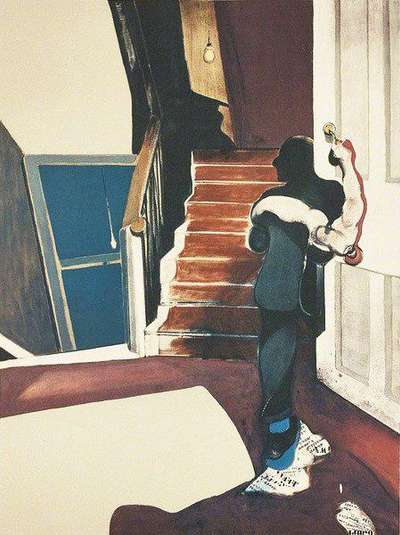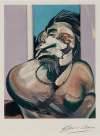In
Memory Of George Dyer
These prints are after Francis Bacon’s 1971 painting, In Memory of George Dyer. Bacon pays tribute to former lover and muse, George Dyer, who took his own life after a long battle with alcoholism and depression. Bacon described his painting as an “exorcism” of the guilt he felt at that time.
Francis Bacon In Memory Of George Dyer For sale
In Memory Of George Dyer Value (5 Years)
With £9051 in the past 12 months, Francis Bacon's In Memory Of George Dyer series is one of the most actively traded in the market. Prices have varied significantly – from £1212 to £10500 – driven by fluctuations in factors like condition, provenance, and market timing. Over the past 12 months, the average selling price was £4525, with an average annual growth rate of 5.95% across the series.
In Memory Of George Dyer Market value
Auction Results
| Artwork | Auction Date | Auction House | Return to Seller | Hammer Price | Buyer Paid |
|---|---|---|---|---|---|
 After Triptych In Memory Of George Dyer (left panel) Francis Bacon Signed Print | 25 Sept 2025 | Christie's London | £5,100 | £6,000 | £8,500 |
 After Triptych In Memory Of George Dyer (centre panel) Francis Bacon Signed Print | 24 Sept 2025 | Sotheby's London | £1,955 | £2,300 | £3,200 |
Sell Your Art
with Us
with Us
Join Our Network of Collectors. Buy, Sell and Track Demand
Meaning & Analysis
This collection of prints takes its name from a painting created by Irish-born British painter Francis Bacon in 1971. Entitled In Memory of George Dyer, the work is a visual tribute to one of Bacon’s former lovers and foremost muse, George Dyer, whom he first met in 1963. As the mythology goes, it is unknown where Bacon and Dyer - a career criminal from London’s East End who spent much of his life in prison - first met. Some say the pair first crossed paths in a Soho drinking hole of the kind Bacon often frequented; others say they first met eyes in Bacon’s flat when Dyer decided to burgle it. The latter episode, immortalised by the 1998 film, Love Is The Devil: Study for a Portrait of Francis Bacon, is now widely denounced as false, yet this does little to undermine the intensity of the pair’s relationship – and interdependence – nor the string of paintings it produced.
Whether Dean Street’s Colony Room Club (a haunt of young British artists Tracey Emin and Damien Hirst), the Coach and Horses on Greek Street, or the landing of Bacon’s house, the pair’s meeting place is unimportant; what is sure, is that their personal and romantic relationship went on to become a defining feature of Bacon’s life and work. In the year of this painting’s completion, however, the pair’s relationship came to its end: two days before the opening of Bacon’s career-defining retrospective at Paris’s Grand Palais, Dyer took his own life after a long struggle with alcoholism and depression. Along with the artist’s Triptych August 1972, which depicts the moments before and after Dyer’s suicide, In Memory Of George Dyer serves the purpose of what Bacon once described as an ‘exorcism’. Designed to rid him of his guilt surrounding his onetime partner’s death, the triptych places Dyer at the centre of its three panels, depicting him with a fondness and dignity very much absent from other more uncompromising works.
Unusual in the scheme of Bacon’s work, the painting draws from the literary canon; the first panel in the sequence, which depicts a characteristically ‘fluid’ human form, is directly inspired by T.S. Eliot’s world-famous poem, ‘The Waste Land’ (1922). As is visible in the print After Triptych In Memory Of George Dyer (centre panel), Dyer’s deconstructed body is set against an eerie staircase, a window, and a lightbulb in the painting’s second ‘act’. In the final panel, mirror-images of Dyer’s profile are set up on a pedestal in tribute to his importance for Bacon. This image in particular is reminiscent of another three-partite work, Three Studies For A Portrait Of George Dyer, 1963.








